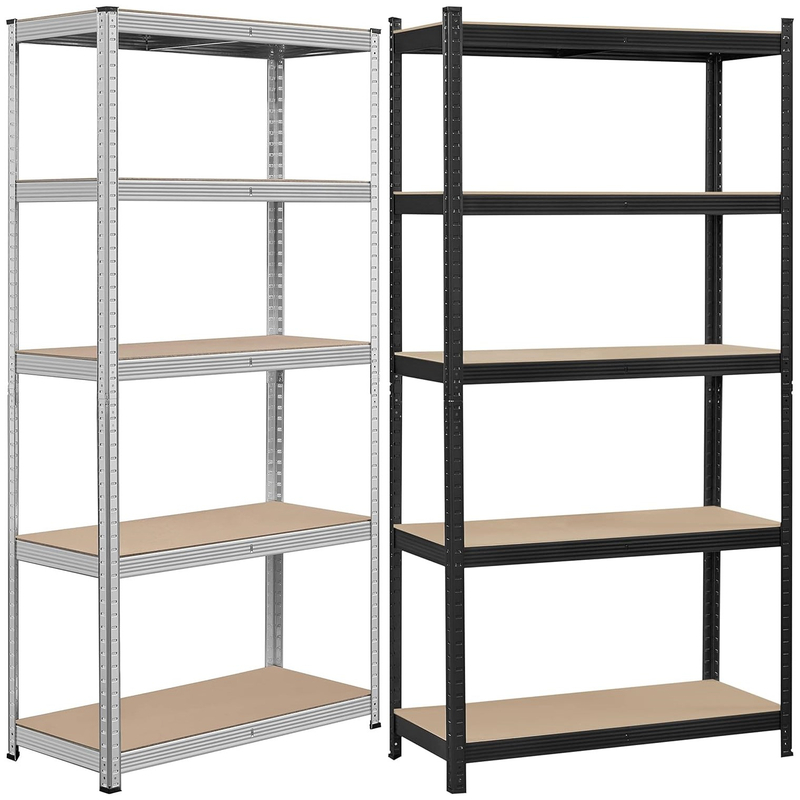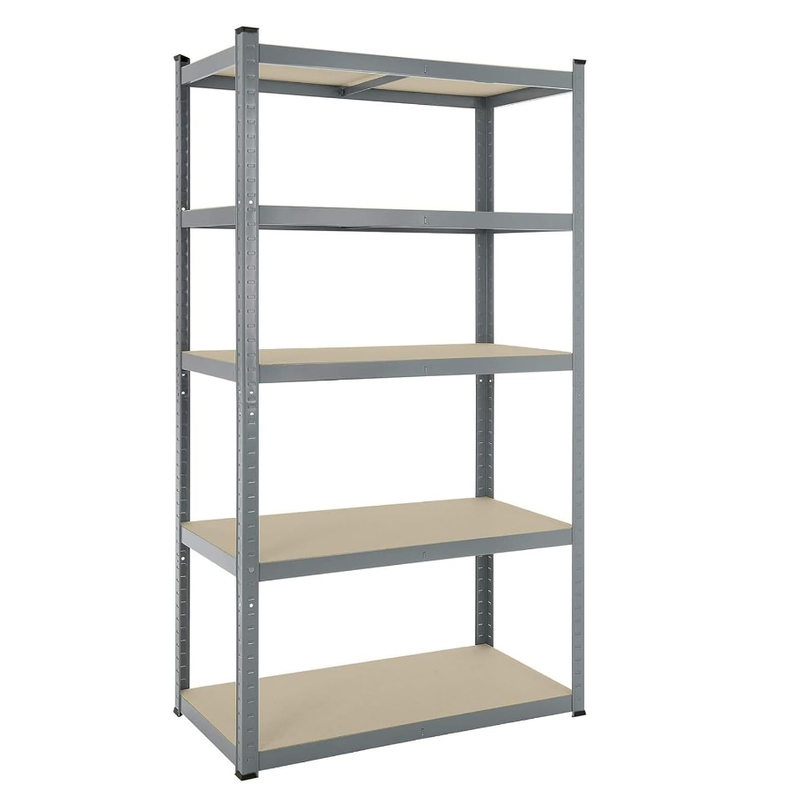- All
- Product Name
- Product Keyword
- Product Model
- Product Summary
- Product Description
- Multi Field Search
Views: 0 Author: Site Editor Publish Time: 2025-06-20 Origin: Site









MDF board shelving is quickly becoming a top choice for those looking to organize their space. But what exactly is MDF, and why is it so popular?
Medium Density Fiberboard (MDF) is an affordable, durable material widely used in shelving solutions. It offers versatility, stability, and a smooth surface that makes it ideal for a variety of applications.
In this article, you’ll learn why MDF board shelving is the perfect solution for both home and business storage needs. From its benefits to common uses, we'll cover everything you need to know.

MDF board shelving offers a budget-friendly option for those seeking reliable storage solutions. When compared to solid wood, MDF is typically more affordable. Solid wood, though durable and aesthetically pleasing, comes at a higher price point.
Typical pricing for MDF shelving can range from $10 to $30 per unit, depending on size and finish, making it an attractive choice for large-scale storage needs. The affordability of MDF shelves makes it ideal for home and commercial spaces, especially when purchasing in bulk.If you want to learn more about the price of MDF shelving and how it compares to other materials, check out this guide on How long will MDF board last?
MDF shelves are designed to last. Unlike other materials, MDF resists warping and cracking over time. The uniform density of MDF allows it to bear weight without compromising its structure, even under heavy usage. Whether you're storing books, electronics, or decorative items, MDF shelving ensures stability.
These boards are stable, even when used for extended periods, making them suitable for long-term storage solutions. The quality of MDF boards can vary, but high-density options are available to handle heavier loads without bending or breaking.
MDF board shelving is incredibly versatile. It can be cut to size easily and painted or finished in a variety of ways, making it perfect for DIY projects. Whether you’re looking to match your existing decor or create custom storage for your space, MDF is adaptable to all needs.
Its ease of installation is another perk. With boltless construction, MDF shelves can be quickly assembled without the need for professional tools or expertise. This user-friendly feature makes MDF an ideal choice for those who want practical and cost-effective storage solutions.
Many popular shelving systems, such as long-span or heavy-duty racks, integrate MDF boards to increase stability and usability. These systems are commonly used in both home and commercial settings.
MDF shelving often comes with high-quality anti-slip pads, preventing items from shifting or falling. These pads enhance safety, especially in high-traffic areas or when storing delicate items.
Additionally, the smooth surface of MDF boards helps protect against scratches and wear. This makes it an excellent choice for display shelves in retail environments, as well as for home storage units that need to withstand daily use.
MDF board shelving is a great choice for organizing your home. Whether it's for your closet, bathroom, kitchen, or living room, MDF shelves offer practical and stylish storage solutions. You can use them to store everything from books to kitchen essentials.
For high-moisture areas like bathrooms and kitchens, MDF is designed to be moisture-resistant, ensuring durability even in humid environments. This makes it an ideal material for storage units that need to stand up to everyday use and moisture.
If you're deciding between MDF and plywood for closet shelves, check out this comparison: Should I use MDF or plywood for closet shelves?
MDF shelves can also be customized to fit your home decor. You can create personalized spaces like custom wardrobes or unique living room shelving, adding both functionality and style.
MDF shelving plays a vital role in commercial and industrial settings. In warehouses, retail stores, and offices, it offers a reliable and efficient way to store inventory or display products. MDF shelving systems are built to withstand heavy use, ensuring stability even with substantial weights.
In retail, MDF boards are often used for store shelving units and display racks. Their smooth surface and durability make them perfect for showcasing products, providing a stable platform for items that need to be displayed attractively. Customizable MDF boards allow businesses to design shelves that fit their specific display needs.
MDF board shelving isn't limited to residential or commercial uses. It’s also widely used in specialized environments like libraries, art galleries, warehouses, and exhibition spaces. In these settings, MDF provides flexible, strong shelving solutions that support large volumes of books, artwork, or inventory.
MDF's sustainability also makes it a great option for eco-friendly storage solutions. Many industries use MDF shelves because the material can be sourced responsibly, contributing to a greener environment. The versatility of MDF makes it suitable for a wide range of specialized storage needs.

When selecting MDF board shelving, consider the thickness, density, and finish options. The thickness of the board impacts its strength and load-bearing capacity. If you need to support heavier items, opt for thicker MDF boards. Denser boards are also stronger and more durable.
The finish of MDF boards is another crucial factor. Melamine and laminate finishes provide a smooth, durable surface that resists scratches, making them ideal for functional use in kitchens or offices. Raw MDF offers more flexibility for custom finishes and decorative purposes, such as painting or covering with wood veneer.
Each finish type serves different purposes. For decorative uses, choose laminate or melamine for a polished look. For functional applications, raw MDF can be treated to enhance its durability.
Before choosing MDF shelving, it's essential to determine the right size for your space. Measure the available area and decide how much shelf space you need. Don’t forget to account for the weight and type of items you'll store.
MDF is easy to work with, so it’s perfect for DIY shelving projects. You can cut it to any size and customize the design to fit your space. Whether you’re creating a modern look with sleek lines or a vintage vibe with distressed finishes, MDF offers plenty of design possibilities.
Add personal touches with paint, stickers, or laminate coverings to match your room’s theme. MDF can easily be transformed to suit both contemporary and classic styles.
MDF boards are an excellent choice for longspan shelving systems. These systems are ideal for irregularly shaped items or customized storage needs. You can arrange the MDF shelves in a way that maximizes your space, allowing for the storage of large or bulky items.
Longspan shelving using MDF is often seen in warehouses or larger home storage areas. It offers flexible, strong, and cost-effective shelving solutions that adapt to various storage needs.
MDF and solid wood are both popular choices for shelving, but they differ in several ways. MDF is generally more affordable than solid wood, making it a budget-friendly option for large-scale storage projects. However, solid wood offers a more natural look and can be more durable over time.
MDF shelves require less maintenance since they don’t expand or contract with humidity, unlike solid wood. Solid wood shelves, while stronger, are prone to warping and cracking, especially in moist environments.
When comparing weight and strength, solid wood typically handles heavier loads better, but MDF offers enough strength for most household and commercial storage needs. It’s also lighter, making it easier to handle during installation.
MDF and particle board are similar, but there are some key differences. MDF boards have a smooth surface, making them ideal for a polished finish, whereas particle board often requires extra veneering due to its rough texture.
In terms of durability, MDF is stronger and more stable than particle board, especially when it comes to weight-bearing. Particle board tends to crumble and sag under heavy loads, while MDF can handle more substantial weight without bending or breaking.
For heavy-duty shelving, MDF is a better choice due to its superior stability and resistance to damage, especially for long-term use.
When comparing MDF to plywood, both materials offer unique benefits. MDF is more flexible in terms of finish options and can be painted or veneered to match any décor. However, plywood offers better strength and flexibility, making it a great choice for heavy-duty shelving.
Plywood is typically stronger and more resistant to bending or warping, making it ideal for storage of heavy or irregularly shaped items. MDF, on the other hand, provides a smoother finish and is easier to work with for custom designs.

Installing MDF board shelving is a simple process. First, gather your materials: MDF boards, screws, a drill, a level, a measuring tape, and brackets. You’ll also need wall anchors if you're mounting the shelves on drywall.
Start by measuring and marking where the shelves will be placed. Use a level to ensure your marks are even. Then, secure the brackets to the wall, making sure they’re strong enough to hold the weight of the MDF boards.
Next, place the MDF boards onto the brackets and screw them in place. Make sure everything is tightly secured, and check the alignment one more time to ensure your shelves are even.
MDF shelving is relatively low-maintenance, but keeping it clean and dry will ensure its longevity. Wipe the shelves regularly with a damp cloth to remove dust. Avoid using abrasive cleaners, as they can damage the surface.
To prevent damage from moisture, ensure your shelves are kept away from humid environments. If used in kitchens or bathrooms, consider using a moisture-resistant finish to protect the boards.
If your MDF shelving gets scratched or chipped, you can easily repair it. For small scratches, simply sand the area lightly and touch it up with paint. For larger damages, apply wood filler, sand it smooth, and then repaint the surface for a seamless look.
MDF board shelving can be an eco-friendly choice when sourced responsibly. Many MDF products are made from recycled wood fibers, which helps reduce waste. By using leftover wood and agricultural byproducts, MDF production limits the need for virgin timber, contributing to a more sustainable material.
MDF also benefits from sustainable forest management practices. Leading manufacturers often ensure their wood comes from responsibly managed forests, certified by organizations like the Forest Stewardship Council (FSC). This ensures that the material is harvested without damaging ecosystems.
When it comes to disposal, MDF boards are recyclable. While they cannot be recycled in the same way as pure wood, they can be repurposed into new products or used for energy recovery. It’s important to check with local waste management facilities for appropriate recycling options to ensure minimal environmental impact.
For responsible disposal, avoid burning MDF due to the chemicals used in its production. Instead, consider donating unused boards or finding eco-friendly recycling programs that specialize in composite materials.
MDF board shelving offers an affordable and versatile storage solution for various needs. It is durable, customizable, and suitable for both home and commercial use. Whether you're organizing your home or displaying products, MDF shelves provide reliable performance.
You can find high-quality MDF shelves at local home improvement stores or online retailers. For more information on selecting the right MDF shelving for your needs, check out this article: Is MDF board good for shelving?
A: MDF shelving can handle moderate weight but may require reinforcement for heavier items. Adding support brackets or using thicker MDF boards can help enhance stability for larger loads.
A: MDF can be used in humid areas like kitchens and bathrooms if moisture-resistant finishes are applied. It’s essential to ensure proper sealing to protect the material from water damage.
A: MDF shelving can last for many years with proper care. Regular cleaning and avoiding exposure to excessive moisture will extend its lifespan.
A: Yes, MDF shelves are perfect for customization. You can easily paint, stain, or apply laminate finishes to match your desired style.
A: MDF shelves are designed for easy assembly, especially with boltless systems that don’t require professional tools, making installation quick and simple.





